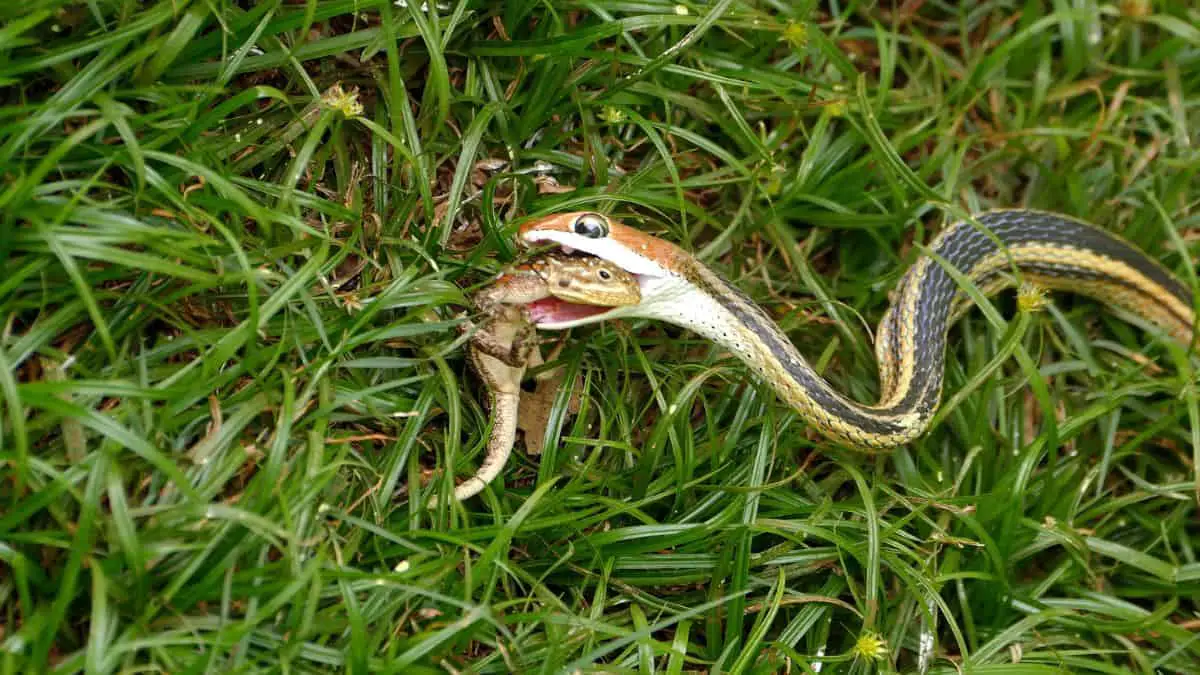How Often Does A Snake Eat? 4 Factors You Need to Know!
Snakes have a rather peculiar feeding habit that sets them apart from most of the other species in the animal kingdom. They might look ferocious at times, but their appetite isn’t all that movies want to make us believe.
So, how often do snakes eat or drink while in the wild or kept at home as pets?
Well, unlike other animals, snakes don’t require feeding regularly. For instance, younger snakes usually tend to feed more often to enable their growth while bigger, snakes only need to feed once in a while depending on the species.
Want to learn how this works? Let’s dive in below!
How Often Does A Snake Eat?
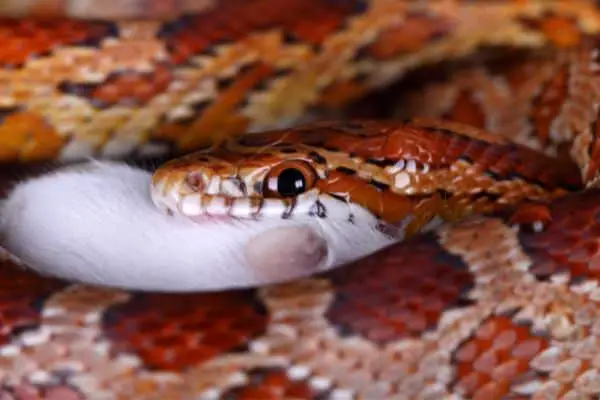
Snakes’ eating habits are influenced by a variety of factors, including their age, size, and level of activity.
1. Age of the Snake
Young snakes are usually fed more often because their bodies are growing rapidly and consume a lot of energy in the process.
They need to take as much food as possible and as often as they can during this early stage of their lives.
Older snakes, on the other hand, can be fed less frequently as they only need food to sustain their energy levels. It’s recommended that they get fed once every one to two weeks at the very least to keep them healthy.
2. Size of the Snake
Larger snakes can store fat and energy in more places throughout their bodies than their smaller counterparts.
They’ll also consume larger prey to replenish their energy because they expend it so quickly.
Ball pythons, for example, consume food at a frequency of once or twice per week at most. After its last meal, an adult python usually won’t need food for the next 10 to 14 days.
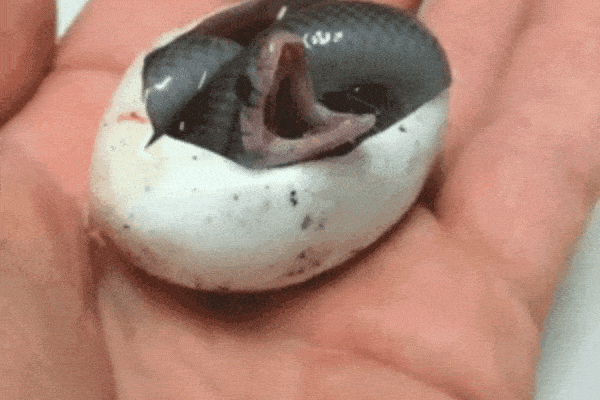
3. Health of the Snake
When a snake gets frequent meals that serve up enough energy to sustain its existence, then it will maintain a steady feeding habit.
If, however, a snake has not been getting enough meals, then it will definitely grow underweight. This means that it will have to eat bigger meals more often to get its health back in shape.
If the snake (wild or pet) is overweight, then it won’t be as active to feed/look for more meals.
4. Opportunity
This is a critical factor that most wild snakes have to deal with when living in their natural habitats.
Every wild snake heavily relies on the right opportunity to hunt, catch prey, and turn it into a meal. Because of this, they have to make the best of every chance that they get while out in the wild.
They won’t shy from going after bigger prey if that’s what has come their way since they don’t know when their next meal will come.
How Often Do Ball Pythons Eat?
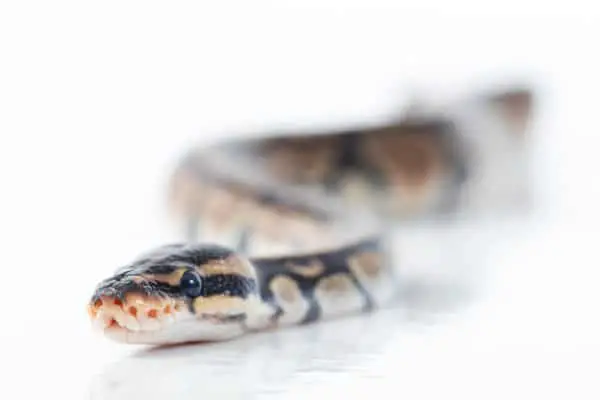
Younger ball pythons usually start with large crickets because their mouths aren’t big enough. Also, they find it a bit much easier to digest the crickets than any other food at this stage of their lives.
When they are a little older, they can progress to “pinkies” (small mice) since their body would have gotten an increased girth and mouth diameter.
Adult ball pythons are capable of eating large rodents such as mice and rats, as they mature.
Make sure that these bigger preys are not wider than the widest point of your snake because this could later lead to problems with digestion.
And because of this, you should also keep an eye out for changes in your snake’s widest girth and thickness as it grows.
How Often Do Snakes Drink Water?
Now, snakes can go up to 14 days without food (on the lower scale) but should always have access to fresh water.
In the case of a pet snake, make sure the water bowl in your cage is made of a durable material that isn’t easily flipped or knocked over. This goes a long way in preventing accidental spills that could leave your pet snake thirsty for long if you’re not aware.
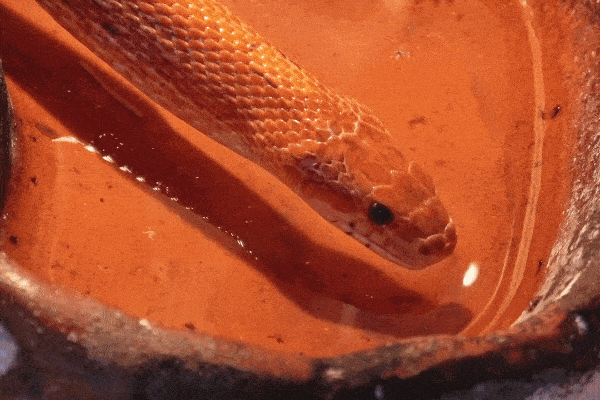
A lot of snakes are picky when it comes to water, and they won’t drink if it isn’t changed daily.
Changing the water frequently and ensuring that it is fresh for your pet is especially important in these situations.
Also, if the water bowl is placed near a source of heat, it will help to keep your enclosure’s humidity levels high.
What Do Pet Snakes Eat?
All snakes are carnivorous. And with that said…
Smaller pet snakes, in most cases, prefer to consume insects and bird eggs since they’re a bit easier to swallow and digest.
But even so, their eating plan varies from one snake species to another as it’s explained in our food chain vs food web article.
Depending on the species that you’re keeping, some snakes may have a palate for birds and small rodents such as mice and rats while others may like eating amphibians such as toads and frogs.
Some smaller snake species have also been known to eat slugs and earthworms.
The bigger ones prefer to consume larger prey, which includes animals such as grown rabbits. However, you have to be careful with your prey selection because some animals eat snakes too.
Why is My Pet Snake Not Eating?
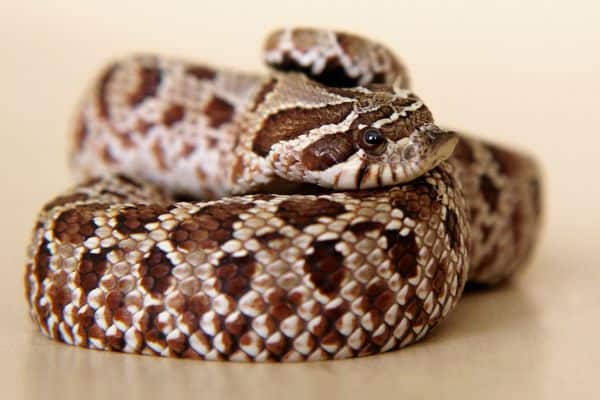
Snakes usually have a good idea of when they need to feed. Unlike other living beings, snakes eat only for energy when it’s required, rather than for pleasure.
So, if your snake is not eating, then it may be because…
- It might not be hungry. If your snake is full, it won’t accept any food that you put in its enclosure during that time. Yes, they are decent like that.
- There’s also the possibility that it’s shedding its old skin. Snakes typically don’t start eating again until they’ve completed their shedding cycle.
- Snakes are also picky eaters when it comes to their diet. Your snake may be refusing to eat if you’ve recently changed the type of food that you’re feeding it with.
- There is also a possibility that your prey may have become “stale” especially if it has been in the freezer for too long. Always keep an eye out for stored snake food to prevent them from going bad on your watch.
There are other more worrying reasons why your snake could stop eating.
These include:
- A new plant was recently added to the enclosure and is affecting the snake’s well-being. You should always check with your vet to find out whether your pet may be allergic to specific plants before adding them inside the snake’s enclosure.
- The temperature has dipped below the optimal range. Snakes need to have optimal temperatures in their environment to support their digestive process. If the temperature dips too low then it will cause the snake to suffer indigestion.
- When a snake is under a lot of stress, it may not be able to eat at all. If you can, keep your snake in a quiet and calm room away from any disturbance that may induce stress on it.
Tips for Feeding Snakes at Home
If you are a snake pet owner, then you should be very careful when it comes to feeding and handling your snakes during meals.
Therefore, to make the best of your snake’s feeding time:
- You may need to spread out the meals to try and accommodate your snake species’ feeding schedule. This ensures that you neither overfeed nor underfeed the snake; it can be detrimental to the snake’s health.
- If your snake shows signs of obesity, you should delay meals even further. Obesity is dangerous for your snake’s (or any other animal’s) health in the long run.
- On the other hand, never feed your snake anything bigger than the size of the largest girth of its body, as this can cause problems with swallowing and digestion.
- Stick to your feeding routine and only feed the snake lifeless prey if you can. There’s a chance your snake could be harmed by live prey should a struggle ensue.
Frequently Asked Questions
How long can a snake go without a meal?
Adult snakes can usually survive for at least two to three weeks without food once they’ve grown out of their juvenile stage. A baby snake will starve to death in about a week.
However, the length of time it takes a snake to starve varies greatly among species depending on their health, age, size, and feeding opportunities.
A species like a ball python can go up to 6 months without a meal, but smaller snakes tend to feed more frequently. Compared to other animals, doing nothing uses lesser energy in snakes than it would for most mammals.
How frequently do snakes defecate?
The number of feeds a snake receives determines how often it will need to empty out.
Defecation occurs more frequently when a snake eats a lot of food within short timelines.
In the case of ball pythons, the average time between feeding and pooping is somewhere between 5 to 7 days.
Unlike humans and other mammals, snakes do not poop at the same time or in the same way too.
How often do snakes shed?
In general, a snake sheds anywhere from two to four times per year, depending on its species.
Because they grow so quickly and must adapt to so many changes, young snakes shed more frequently, sometimes every few weeks.
The number of sheds a snake produces depends on its size, age, and species.

